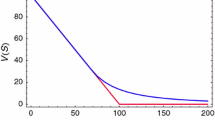Abstract
In this paper we present a stable finite difference scheme on a piecewise uniform mesh along with a power penalty method for solving the American put option problem. By adding a power penalty term the linear complementarity problem arising from pricing American put options is transformed into a nonlinear parabolic partial differential equation. Then a finite difference scheme is proposed to solve the penalized nonlinear PDE, which combines a central difference scheme on a piecewise uniform mesh with respect to the spatial variable with an implicit time stepping technique. It is proved that the scheme is stable for arbitrary volatility and arbitrary interest rate without any extra conditions and is second-order convergent with respect to the spatial variable. Furthermore, our method can efficiently treats the singularities of the non-smooth payoff function. Numerical results support the theoretical results.
Similar content being viewed by others
References
Angermann L., Wang S. (2007) Convergence of a fitted finite volume method for the penalized Black-Scholes equation governing European and American option pricing. Numerische Mathematik 106: 1–40
Black F., Scholes M. S. (1973) The pricing of options and corporate liabilities. Journal of Political Economy 81: 637–654
Courtadon G. (1982) A more accurate finite difference approximation for the valuation of options. Journal of Financial and Quantitative Analysis 17: 697–703
Cox J. C., Ross S., Rubinstein M. (1979) Option pricing: A simplified approach. Journal of Financial Economics 7: 229–264
Forsyth P. A., Vetzal K. R. (2002) Quadratic convergence for valuing American options using a penalty method. SIAM Journal on Scientific Computing 23(6): 2095–2122
Hull J. C., White A. (1988) The use of the control variate technique in option pricing. Journal of Financial and Quantitative Analysis 23: 237–251
Ikonen S., Toivanen J. (2004) Operator splitting methods for American option pricing. Applied Mathematics Letters 17: 809–814
Jaillet P., Lamberton D., Lapeyre B. (1990) Variational inequalities and the pricing of American options. Acta Applicandae Mathematicae 21: 263–289
Kangro R., Nicolaides R. (2000) Far field boundary conditions for Black-Scholes equations. SIAM Journal on Numerical Analysis 38: 1357–1368
Nielsen B. F., Skavhaug O., Tveito A. (2002) Penalty and front-fixing methods for the numerical solution of American option problems. Journal of Computational Finance 5: 69–97
Rogers L. C. G., Talay D. (1997) Numercial methods in finance. Cambridge University Press, Cambridge
Schwartz E. (1977) The valuation of warrants: Implementing a new approach. Journal of Financial Economics 4: 79–93
Vazquez C. (1998) An upwind numerical approach for an American and European option pricing model. Applied Mathematics and Computation 97: 273–286
Wilmott P., Dewynne J., Howison S. (1993) Option pricing: Mathematical models and computation. Oxford Financial Press, Oxford, UK
Wu X., Kong W. (2005) A highly accurate linearized method for free boundary problems. Computers and Mathematics with Applications 50: 1241–1250
Zvan R., Forsyth P. A., Vetzal K. R. (1998a) A general finite element approach for PDE option pricing models. University of Waterloo, Canada
Zvan R., Forsyth P. A., Vetzal K. R. (1998b) Penalty methods for American options with stochastic volatility. Journal of Computational and Applied Mathematics 91: 199–218
Author information
Authors and Affiliations
Corresponding author
Rights and permissions
About this article
Cite this article
Cen, Z., Le, A. & Xu, A. A Second-Order Difference Scheme for the Penalized Black–Scholes Equation Governing American Put Option Pricing. Comput Econ 40, 49–62 (2012). https://doi.org/10.1007/s10614-011-9268-9
Accepted:
Published:
Issue Date:
DOI: https://doi.org/10.1007/s10614-011-9268-9
Keywords
- Black–Scholes equation
- Option valuation
- Power penalty method
- Central difference scheme
- Piecewise uniform mesh




